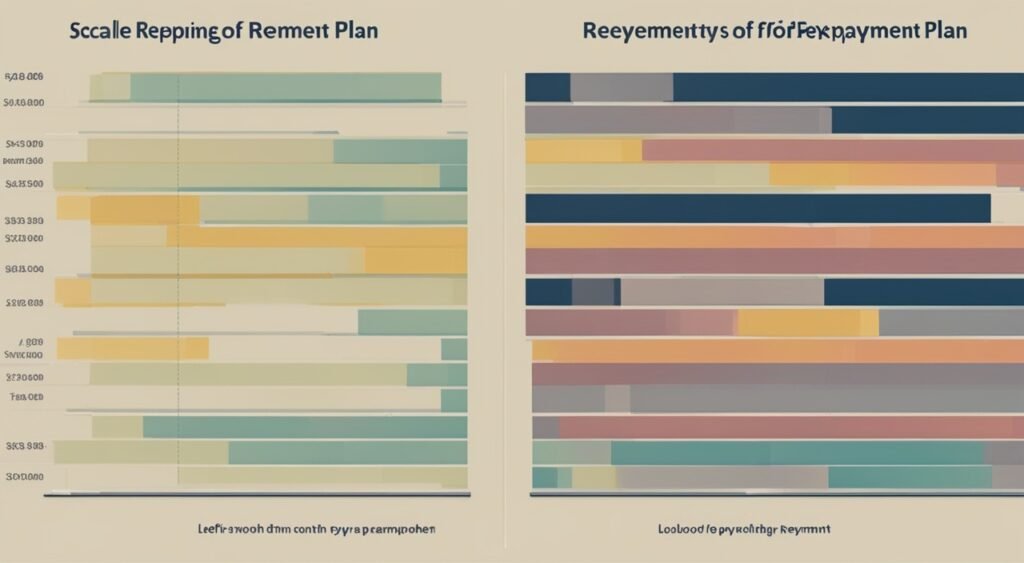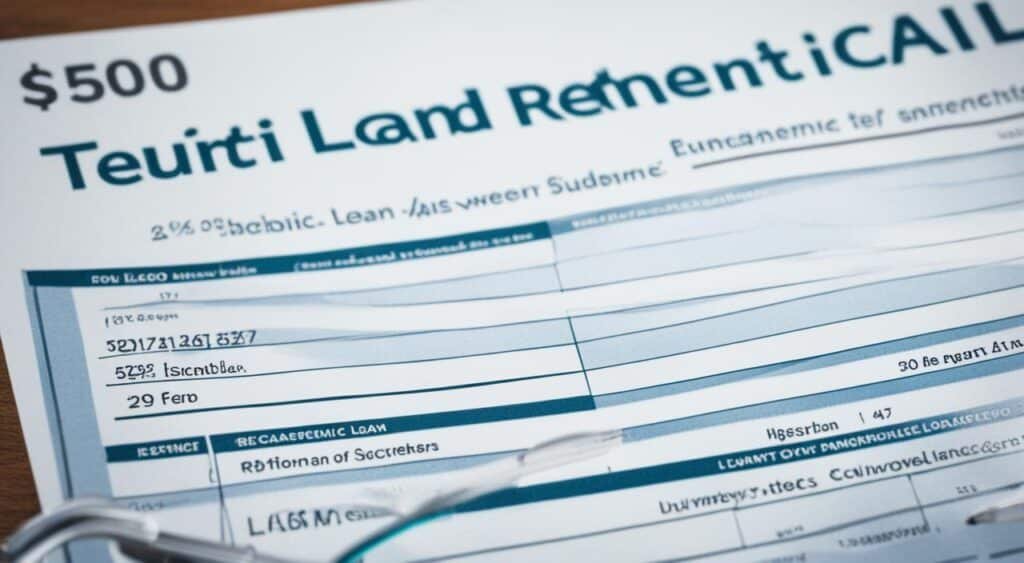Understanding Your Student Loan Repayment Options
Dealing with student loan repayment can feel overwhelming. Whether you have federal or private loans, knowing your options is key. This article will cover federal loan plans like standard, income-driven, graduated, and extended ones. We’ll also look at private loan options and the Public Service Loan Forgiveness program.
We’ll talk about how the COVID-19 pandemic has affected student loans. We’ll also discuss other things to think about when picking a repayment plan that fits your needs.
Key Takeaways
- Federal student loan borrowers have several repayment plan options, including standard, income-driven, graduated, and extended plans.
- Choosing the right repayment plan depends on factors like interest rates, monthly payments, and the goal of achieving loan forgiveness.
- The Public Service Loan Forgiveness program offers loan forgiveness for eligible borrowers who work in public service jobs.
- The COVID-19 pandemic has impacted student loan repayment, with various relief measures and options available to borrowers.
- Carefully evaluating your financial situation and goals is crucial when selecting the best repayment plan for your federal or private student loans.
Types of Federal Student Loan Repayment Plans
Finding the right federal student loan repayment plan can be tricky. But knowing the options is key to picking the best one for you. There are four main types: standard, income-driven, graduated, and extended plans.
Standard Repayment Plan
The standard repayment plan is the default choice for borrowers. It requires fixed monthly payments over 10 years. This plan is the quickest way to pay off your standard repayment plan. Even though payments might be higher, it can save you money on interest over time.
Income-Driven Repayment Plans
Income-driven repayment plans adjust your monthly payment to a part of your income, usually 10-20%. These plans include PAYE, REPAYE, IBR, and ICR. They offer lower payments and the chance for loan forgiveness after 20-25 years of payments.
Graduated Repayment Plan
The graduated repayment plan starts with lower payments that increase every two years for 10 years. It’s good for borrowers expecting their income to grow. The payments will match your increasing income.
Extended Repayment Plan
The extended repayment plan extends your loan repayment up to 25 years for lower monthly payments. But, this might mean paying more in interest over the loan’s life.
| Repayment Plan | Repayment Period | Monthly Payment | Forgiveness |
|---|---|---|---|
| Standard | 10 years | Fixed | No |
| Income-Driven | 20-25 years | Percentage of discretionary income | Yes, after 20-25 years |
| Graduated | 10 years | Gradually increasing every 2 years | No |
| Extended | Up to 25 years | Lower monthly payments | No |
Understanding the different federal student loan repayment options helps you choose the best plan for your goals. Whether you want lower payments, less interest, or loan forgiveness, there’s a plan for you.
Choosing the Right Repayment Plan

Choosing the right repayment plan for your student loans is crucial. It affects your financial goals, like paying less interest or getting lower monthly payments and potential loan forgiveness.
If You Want to Pay Less Interest
The standard repayment plan is great if you want to pay less interest. It has the shortest repayment time, usually 10 years. This means you’ll pay off your loans quicker and save on interest.
If You Want Lower Monthly Payments and Student Loan Forgiveness
If you’re finding it hard to pay your monthly payments, consider an income-driven repayment plan. Your payments will be based on your income. You might even get loan forgiveness after 20 or 25 years of payments.
Think about your financial situation and goals to decide between these options. By looking at your choices, you can pick the repayment plan that fits your needs and helps you reach your financial goals.
“The key to managing your student loans is finding the right balance between affordability and long-term cost savings.”
Income-Driven Repayment Plans in Detail

If you’re struggling with student loan debt, income-driven repayment plans can help. These plans include the PAYE, SAVE, and IBR plans. They set your monthly payments at 10-20% of what you can afford to pay each month.
Pay As You Earn (PAYE) Plan
The PAYE plan limits your monthly payments to 10% of your income. After 20 years of payments, you might get your loans forgiven. This plan makes sure payments are affordable, even if you owe a lot.
Saving on a Valuable Education (SAVE) Plan
The SAVE plan started in 2023. It’s a new way to help borrowers pay less, with payments at 5-10% of your income. After 20 or 25 years, any loan left can be forgiven.
Income-Based Repayment (IBR) Plan
The IBR plan also caps payments at 15% of your income. You can get your loans forgiven after 25 years of payments. If your income is low, your payments could be as little as $0.
Choosing income-driven repayment plans helps keep your payments low. This is key for managing your discretionary income and getting closer to student loan forgiveness. It’s a smart way to achieve financial stability.
Student Loan Repayment Options for Private Loans

Federal student loans offer many repayment plans, but private student loans have fewer choices. Still, knowing what options are available can help borrowers find a plan that fits their budget.
For private student loans, borrowers can choose from immediate repayment, interest-only payments, fixed payments, and full deferment. If they’re having trouble financially, they might be able to get deferment or forbearance. But these options aren’t always available.
Refinancing a private student loan can also save money. By getting a lower interest rate, borrowers might pay less over time. But, they need a good credit score and financial situation for this.
| Repayment Option | Description |
|---|---|
| Immediate Repayment | Borrowers make full monthly payments, including principal and interest, immediately after the loan is disbursed. |
| Interest-Only Payments | Borrowers make monthly payments to cover only the interest on the loan, with the principal balance remaining unchanged. |
| Fixed Payments | Borrowers make a predetermined monthly payment, which may include both principal and interest. |
| Full Deferment | Borrowers can temporarily postpone making any payments on the loan, though interest may continue to accrue during this period. |
Understanding the repayment options for private student loans helps borrowers make smart choices. They can pick a strategy that matches their financial goals and situation.
Factors to Consider When Choosing a Repayment Plan

When picking a student loan repayment plan, it’s important to look at several key things. These include your current income, expected future earnings, total debt burden, and credit history.
If you have a low income or a lot of debt compared to your earnings, income-driven repayment plans might be best. These plans set your monthly payments based on a part of your discretionary income. This can make your payments more manageable. But, if you have a high income and can handle bigger payments, a standard or graduated repayment plan could work better for you.
Being married and how you file taxes can also affect your repayment plan. Think about how these things might change your monthly payments and your overall debt situation.
| Factor | Consideration |
|---|---|
| Income | Lower income may favor income-driven plans, while higher income may suit standard or graduated repayment |
| Debt Burden | Income-driven plans can be beneficial for those with high debt relative to income |
| Credit History | Strong credit history may allow for more flexible repayment plan options |
| Marital Status | Marital status and tax filing status can impact monthly payments and long-term debt obligations |
By thinking about these factors, you can make a smart choice. You can pick the repayment plan that fits your financial situation and goals best.
Student Loan Repayment

As the COVID-19 pandemic eases, federal student loan repayments will start again in the fall of 2023. Borrowers will get their first billing statements in September, with payments due in October. The student loan repayment process means making regular payments to your loan servicer. They will use the money to pay down your student loan balance.
To get ready for resume payments, borrowers should check their repayment options. Make sure your contact info is current with your loan servicer. This makes the repayment process smoother and prevents delays.
Borrowers have a few ways to handle student loan repayment, including:
- Standard Repayment Plan: A fixed monthly payment for up to 10 years.
- Income-Driven Repayment Plans: Adjust monthly payments based on your income and family size.
- Graduated Repayment Plan: Start with lower payments that gradually increase over time.
- Extended Repayment Plan: Extend the repayment period to up to 25 years, with fixed or graduated payments.
Choosing the right repayment plan can make managing your student loan repayment easier. It might even save you money on interest over the loan’s life. Borrowers should think about their finances and goals when picking a plan.
By staying informed and proactive, borrowers can confidently handle the student loan repayment process. This ensures a smooth return to regular payments.
Public Service Loan Forgiveness Program

The Public Service Loan Forgiveness (PSLF) program helps federal student loan borrowers. It’s for those working in public service jobs. After making 120 payments, they can have their loans forgiven.
Eligibility and Requirements
To get into the PSLF program, you must:
- Work full-time for a U.S. federal, state, local, or tribal government or a non-profit
- Have federal Direct Loans or consolidated them into a Direct Consolidation Loan
- Be in an income-driven repayment plan or the standard plan
- Make 120 qualifying payments, which are on-time, full payments after October 1, 2007
Only 3.3% of applicants got forgiveness by June 2023. But, the Department of Education is working to help more borrowers.
| Requirement | Details |
|---|---|
| Employment | Full-time work for a U.S. federal, state, local, or tribal government or a qualifying non-profit organization |
| Loan Type | Federal Direct Loans or consolidated federal loans into a Direct Consolidation Loan |
| Repayment Plan | Income-driven repayment plan or standard repayment plan |
| Qualifying Payments | 120 on-time, full payments made after October 1, 2007 |
Knowing about the public service loan forgiveness program helps public sector workers. They can get their student loans forgiven.
Postponing or Reducing Payments
If you’re a federal student loan borrower facing financial hardship, there are ways to help. You can either postpone or reduce your monthly payments. Deferment and forbearance are two main options.
Deferment and Forbearance
Deferment lets you stop making payments for a while. Forbearance lowers the amount you pay each month. These options can ease your financial burden. But, it’s key to know what they mean.
With deferment or forbearance, you’ll still owe interest on your loans. This means your loans will cost more over time. That’s why income-driven repayment plans might be a better choice for long-term relief.
Deciding between deferment and forbearance depends on your situation. You should look at the terms and think about how they’ll affect your loan and interest. Talking to your loan servicer can help you make a smart choice and find ways to postpone or reduce payments.
“Deferment and forbearance can provide temporary relief, but they come with potential trade-offs. It’s essential to understand the long-term implications before deciding which option is best for your financial situation.”
Impact of the COVID-19 Pandemic

The COVID-19 pandemic has greatly affected student loan repayment. To help with economic challenges, the federal government stopped student loan payments and interest from adding up. This break has been extended a few times and is set to end in October 2023.
Soon, borrowers will have to start making their regular monthly payments again. But, the government has a plan to make things easier for a year after the break ends. During this time, borrowers who struggle to pay won’t be seen as delinquent or face serious consequences.
This break has given many COVID-19 student loan borrowers some much-needed financial relief. But, with the repayment pause ending, borrowers must get ready to start paying back their loans. They also need to deal with any interest accrual that happened during the break.
“The COVID-19 pandemic has caused significant financial hardship for many Americans, and student loan borrowers have not been spared,” says financial expert Sarah Johnson. “The repayment pause has been a lifeline, but the end is in sight, and borrowers need to have a plan in place to ensure a smooth transition back to regular payments.”
Understanding how the COVID-19 pandemic has affected student loan repayment and the options available helps borrowers make smart choices. This way, they can manage their debt better. federal student aid perkins loan for federal family education loan may plus loan may be eligible contact your loan servicer , repay your loan idr plan , ffel consolidate your loans count toward assessing the ruling in july 18 2024 toward loan. different repayment plan available on federal student loans and qualify for forgiveness, eligible for pslf to held by ed,
Also Read: Can Payday Loans Solve Your Short-term Financial Needs?
Conclusion
It’s important for borrowers to know about different student loan repayment options. This helps them manage their debt and pick the best plan for their finances. Federal student loans offer many choices, like a 10-year standard plan or income-driven plans that could lead to forgiveness.
Private student loans have fewer options, but borrowers might be able to defer, forbear, or refinance their loans. By thinking about their goals and future finances, borrowers can make a repayment plan that works for them. Whether you have federal or private loans, looking into your options and making a smart choice can greatly improve your financial health.
Handling student loan repayment can be complex, but it’s worth it. With the right plan, borrowers can reach their financial goals and respect their education investments. Being careful and diligent can lead to big rewards in managing debt.
FAQs
Q: What is a loan servicer?
A: A loan servicer is a company that handles billing and other services on your student loans.
Q: How can I qualify for teacher loan forgiveness?
A: To qualify for teacher loan forgiveness, you must be a teacher and meet specific requirements outlined by the federal government.
Q: What is a grace period for student loan repayment?
A: A grace period is a period of time after you graduate, leave school, or drop below half-time enrollment before you must begin repaying your student loans.
Q: How can I repay my student loans?
A: You can repay your student loans through various repayment plans offered by the Department of Education or your loan servicer.
Q: What is the process to apply for loan forgiveness?
A: To apply for loan forgiveness, you need to meet specific criteria depending on the type of forgiveness program you are applying for and submit the necessary documentation to your loan servicer.
Q: How can I consolidate my student loans?
A: You can consolidate your student loans by combining multiple federal student loans into one loan with a single servicer.
Q: What is the teacher loan forgiveness program?
A: The teacher loan forgiveness program is a program that offers loan forgiveness for teachers who meet certain criteria and teach in designated low-income schools.
Source Links
- https://www.universityofcalifornia.edu/understanding-your-student-loan-repayment-options
- https://www.investopedia.com/student-loan-repayment-options-what-s-the-best-way-to-pay-4772402
- https://www.nerdwallet.com/article/loans/student-loans/student-loan-repayment-plans
